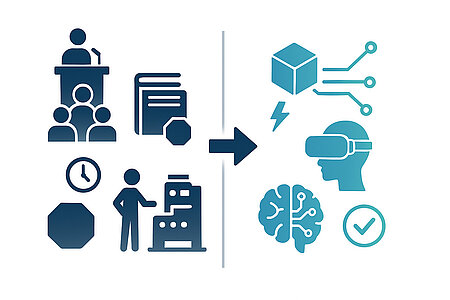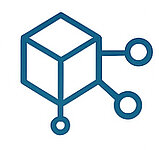Upskilling in medium-sized manufacturing companies - technological approaches from Industry 4.0 and 5.0
24.09.2025
A guide for production managers, management and decision-makers with a focus on technology-supported training in small and medium-sized enterprises (SMEs).

Why technological training is becoming increasingly important
The shortage of skilled workers and the digital transformation are increasing the pressure on manufacturing companies to continuously train their workforce. Traditional training methods - such as face-to-face teaching, standard presentations or one-off induction plans - are often too slow, too inflexible and not individualized enough in today's dynamic industrial environment.
With the advent of Industry 4.0 (networked, digitally controlled production) and the Industry 5.0 concept (human-machine collaboration, sustainability, resilience), new technologies, tools and processes are constantly emerging that bring enormous benefits not only in production itself, but also in training and further education.

Technology-supported training offers:
- Faster familiarization: employees practice new processes in virtual or simulated environments without blocking real machines or taking risks.
- Greater relevance: Content can be tailored to specific work tasks and the current production environment.
- Better motivation: Interactive formats such as AR/VR increase engagement.
- More efficient knowledge transfer: Complex processes are clearly visualized, making them more memorable.

Simulation & digital twins
Explanation: Digital twins are virtual images of machines or complete production lines. They are based on real-time data and enable realistic training in a controlled, safe environment. This allows complex processes to be practiced, sources of error to be simulated and process improvements to be tested without disrupting ongoing operations.
Implementation steps:
- Identify relevant processes or machines.
- Integrate design and operating data (e.g. CAD, IoT sensors).
- Program interactive scenarios, e.g. for troubleshooting or process optimization.
- Conduct training with feedback and analysis functions.
Best practice: A packaging machine manufacturer implemented a digital twin for its main machine series. New employees were able to simulate the production process in 3D and repeat it until they got all the steps right. Result: 25% shorter training times, 18% fewer errors in the first three months of work.

VR/AR-supported training
Explanation: Virtual reality (VR) immerses learners in a completely digital world in which they can train work steps realistically. Augmented reality (AR), on the other hand, expands the real field of vision with additional information such as step-by-step instructions or safety warnings.
Implementation steps:
- Select critical activities (e.g. machine maintenance, assembly).
- Develop or adapt suitable AR/VR content.
- Provide hardware such as VR headsets or AR glasses.
- Conduct training sessions with real-time feedback.
Best practice: An automotive supplier trained employees in maintenance technology with AR glasses that displayed live assembly instructions. This led to a reduction in training time from 14 to 3 days and a significant increase in occupational safety.

AI-supported learning paths
Explanation: AI analyzes individual learning progress, error rates and production data to create tailored learning content. This gives employees exactly the modules they need - in the right order and difficulty level.
Implementation steps:
- Define role and competence profiles.
- Link production and training data.
- Train AI algorithms to generate individual learning paths.
- Continuously monitor progress and adapt content.
Best practice: An electronics manufacturer used AI to adapt training content in real time based on recorded production errors. Within 6 months, training time was reduced by 30% and product quality improved measurably.

Adaptive learning platforms
Explanation: Adaptive platforms adjust the pace, content and difficulty to the user's prior knowledge and learning speed. This increases the efficiency of knowledge absorption and ensures that neither under- nor overload occurs.
Implementation steps:
- Carry out an initial test (assessment) to determine the level of knowledge.
- Divide content into modular units.
- Dynamically adapt learning paths based on test results.
- Offer regular knowledge checks and certificates.
Best practice: A medical technology company met stricter regulatory requirements twice as fast by using adaptive platforms to close specific knowledge gaps.

Networked knowledge databases & collaboration tools
Explanation: All employees can access up-to-date work instructions, best practices and troubleshooting guides at any time via cloud platforms. In conjunction with IoT data, problems can be identified and resolved more quickly.
Implementation steps:
- Create a central database with structured content.
- Standardize content and tag it with keywords.
- Enable access via PC, tablet or smartphone.
- Integrate feedback functions to keep content up to date.
Best practice: A machine manufacturer linked its service database with machine sensors. Employees in the technical department automatically received appropriate repair instructions in the event of faults. This reduced downtimes by 20 %.

Conclusion
Technological training is a key factor for competitiveness and future security in medium-sized manufacturing companies. The methods presented - simulation/digital twins, VR/AR training, AI-supported learning paths, adaptive platforms and networked knowledge databases - offer practical, scalable and measurably effective ways of imparting knowledge quickly and sustainably.
Your contact

As a strong network, we support manufacturing companies, especially SMEs, in the transfer of knowledge, the implementation of new technologies and in securing skilled workers. We regularly organize specialist events, workshops and networking formats to share best practices and promote direct exchange between industry, research and technology providers. Companies can contact us at any time for individual advice, project initiation or cooperation opportunities.